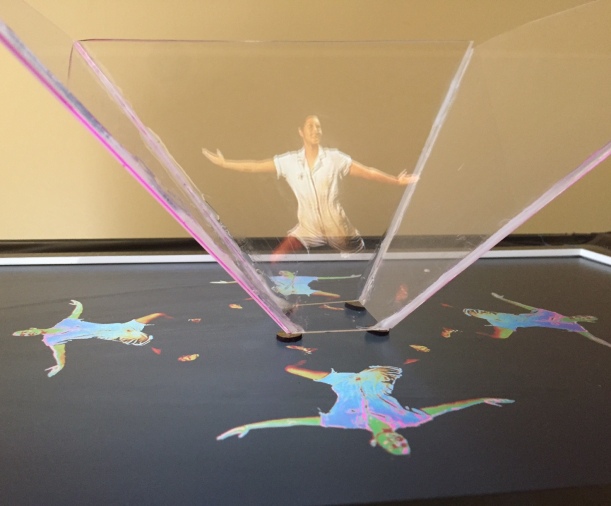
Me as a digital Deep Dream Vision Quest painting.
I grew up on a military base in the wide open Indian Wells Valley of California’s Mojave Desert. With a fantasy-prone mind and a peace loving heart, I felt a sublime fascination with the technology that powered jets up to speeds that broke the sound barrier and left trails in the skies above the China Lake Naval Weapons Center. Yet, my life primarily evolved around home, church, and school, where I learned to color and write, think about God, sing, and dance. My father was a computer programmer, educated as an aeronautical engineer and gifted as a musician and poet. He would play the guitar with pens in his pocket. My mother worked as an accountant and could tap at a mean pace on an adding machine. At home her fingers were more often crocheting elaborate hanging planters, cooking homemade meals, or feeding material through her sewing machine. She was so adept at growing things that she actually made tulips come up in the hard, dry dirt of our backyard. Great with numbers, my mother still writes them with extra beautiful curves.
Since the beginning of human history, the making of things has involved both aesthetics and engineering.
Coming from this home of engineers and artists, I always felt they were naturally parts of one whole. It wasn’t until I ventured into the wider world as an adult that I understood the cultural divide that I now feel compelled to challenge in my work as a science communicator and in my education and experience in the arts.
Fortunately many others are attempting to join what C.P. Snow called “The Two Cultures.” Yesterday, I visited the Life Art Science Tech (LAST) Festival in San Jose, originally conceived by author and historian Piero Scaruffi and organized by the Thymos Foundation. As described on the LAST Festival website, the event combines and fuses these disciplines “to help reshape the cultural environment of the 21st century towards a multidimensional form of individual and social creativity.”

Life Art Science Tech (LAST) Festival in San Jose April 7-8, 2017.
The art exhibit, curated by Joel Slayton, playfully meandered across the art-science divide. Scientific concepts and technology were brought to bear on aesthetic concepts and displays that teased the mind and delighted the senses. Many were interactive pieces that operated on the viewer’s physical presence, movements, or sounds. Gary Boodhoo’s Deep Dream Vision Quest took images of viewers standing in front of a large screen and turned them into a rich dreamscape digital painting of layered familiar shapes, ceaselessly morphing. The piece uses videogames and machine learning to generate what Boodhoo calls “interactive science fiction” that “turns dreaming into a shared experience.”
Gary Boodhoo’s Deep Dream Vision Quest
Cere Davis’ Water Organ looked like a Dr. Seuss laboratory experiment: funny tin vessels moved on water via sound waves and magnets. The ambient sound composition coming from these curious components could be silenced by placing a finger on a strip of tin foil just in front of the sculpture. The softly shifting, goldfish colored sculpture with its dreamy sound patterns had a trance-like effect – all the while, I wondered what invisible forces were at work. According to her bio, sculptor, engineer, musician and dancer Davis plays at the boundaries of “engineering, soulful expression, and laboratory experimentation.”

Water Organ, a kinetic sound sculpture by Cere Davis.
As Daniel H. Pink writes in A Whole New Mind, “Human beings sometimes seem naturally inclined to see life in contrasting pairs.” Science is exact, disciplined, factual, logical, and analytical. Art is open, meandering, and based in emotion. Art is atmospheric; it appeals to our senses. Science is specific; it tells us about reality and enables useful inventions. Yet, even as I write these descriptions in order to place art and science on opposite poles, I see traces of each on the other side of human experience. Science is certainly open to new discoveries, and great artists are precise and rigorously trained. A beautiful equation can give scientists goose bumps, and art has contributed real power to civilizations. Since the beginning of human history, the making of things has involved both aesthetics and engineering.

More than Love on the Horizon hologram at LAST Festival.



